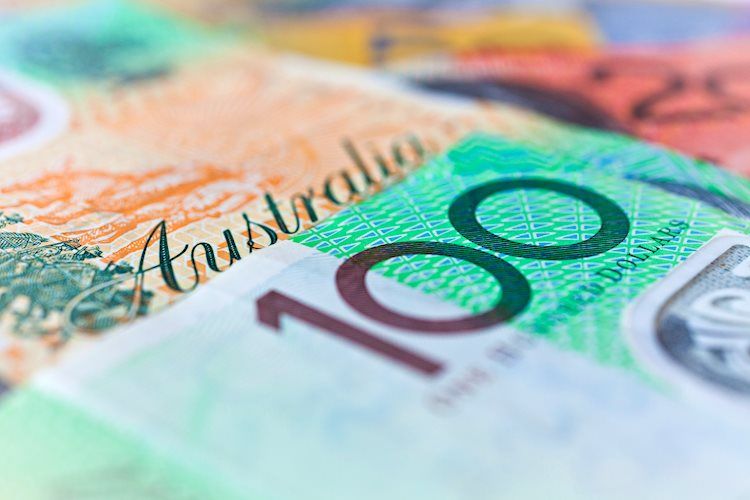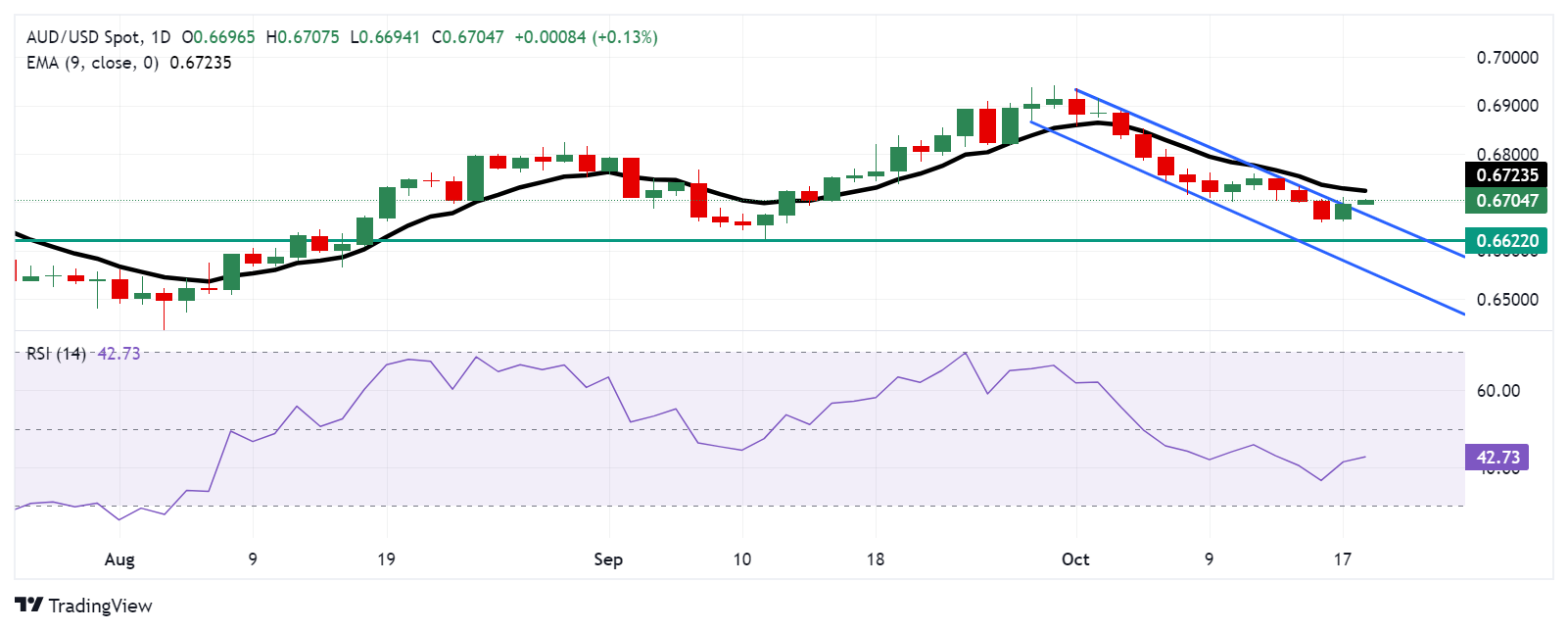- The Australian Dollar rises as the solid employment data diminish the odds of RBA’s rate cuts in 2024.
- China’s Gross Domestic Product is expected to report 4.5% growth YoY in Q3, compared to the previous 4.7% reading.
- The US Dollar received support from a solid US Retail Sales report, fueling the likelihood of the Fed delivering nominal rate cuts.
The Australian Dollar (AUD) continued to strengthen against the US Dollar (USD) for the second consecutive day on Friday. This upside of the AUD/USD pair is largely due to stronger-than-expected domestic employment data released on Thursday, which led traders to scale back expectations of a Reserve Bank of Australia (RBA) interest rate cut this year.
The Australian Dollar may have also gained support from confirmation of rate cuts in China, its largest trading partner. China’s Industrial Commercial Bank, Bank of Communications, and China Merchants Bank announced a 25 basis point cut. Lower interest rates are expected to stimulate domestic economic activity, which in turn could boost demand for Australian exports to China.
The US Dollar (USD) edges lower as Treasury yields decline. However, the Greenback reached a two-month high of 103.87 on Thursday, supported by a solid US Retail Sales report, which fueled expectations that the Federal Reserve (Fed) may implement nominal rate cuts.
According to the CME FedWatch Tool, there is a 90.8% probability of a 25-basis-point rate cut in November and a 74.0% chance of another cut in December.
Daily Digest Market Movers: Australian Dollar rises as solid labor data diminishes RBA rate cuts
- National Australia Bank revised its projection for the Reserve Bank of Australia (RBA) in a note this week. “We have brought forward our expectations for the timing of rate cuts, now anticipating the first cut in February 2025, instead of May,” the bank stated. They continue to foresee a gradual pace of cuts, with rates expected to decrease to 3.10% by early 2026.
- US Retail Sales rose by 0.4% month-over-month in September, surpassing both the 0.1% gain recorded in August and market expectations of a 0.3% increase. Additionally, US Initial Jobless Claims fell by 19,000 during the week ending October 11, the largest decline in three months. The total number of claims dropped to 241,000, significantly below the anticipated 260,000.
- The seasonally adjusted Employment Change in Australia surged by 64.1K in September, bringing the total employment to a record 14.52 million. This far surpassed market expectations of a 25.0K increase, following a revised rise of 42.6K in the previous month. Meanwhile, the Unemployment Rate remained steady at 4.1% in September, matching the revised figure for August and coming in lower than the anticipated 4.2%.
- On Wednesday, Reserve Bank of Australia (RBA) Deputy Governor Sarah Hunter reiterated the central bank’s commitment to curbing inflation, emphasizing that although inflation expectations remain well-anchored, ongoing price pressures continue to present significant challenges.
- On Tuesday, Federal Reserve Bank of Atlanta President Raphael Bostic stated that he anticipates just one more interest rate cut of 25 basis points this year, as reflected in his projections during last month’s US central bank meeting. “The median forecast was for 50 basis points beyond the 50 basis points already implemented in September. My projection was for an additional 25 basis points,” he said, according to Reuters.
- Federal Reserve (Fed) Bank of Minneapolis President Neel Kashkari reassured markets late on Monday by reaffirming the Fed’s data-dependent approach. Kashkari reiterated familiar Fed policymaker views on the strength of the US economy, noting continued easing of inflationary pressures and a robust labor market, despite a recent uptick in the overall unemployment rate, per Reuters.
Technical Analysis: Australian Dollar breaks above 0.6700, descending channel
The AUD/USD pair trades around 0.6710 on Friday. A technical analysis of the daily chart shows that the pair has successfully broken above the descending channel pattern, indicating a potential shift from a bearish to a bullish trend. However, the 14-day Relative Strength Index (RSI) remains below 50, suggesting that bearish sentiment is still prevalent.
On the upside, the AUD/USD pair could test the nine-day Exponential Moving Average (EMA) at 0.6724, followed by a key psychological resistance at 0.6800.
Regarding support, the pair may attempt to re-enter the descending channel. A successful return could reinforce the bearish outlook, with the pair potentially targeting its eight-week low of 0.6622, last seen on September 11, and then the lower boundary of the descending channel around 0.6580.
AUD/USD: Daily Chart
Australian Dollar PRICE Today
The table below shows the percentage change of Australian Dollar (AUD) against listed major currencies today. Australian Dollar was the strongest against the US Dollar.
| USD | EUR | GBP | JPY | CAD | AUD | NZD | CHF | |
|---|---|---|---|---|---|---|---|---|
| USD | -0.03% | -0.09% | -0.12% | -0.03% | -0.13% | -0.07% | 0.01% | |
| EUR | 0.03% | -0.04% | -0.08% | -0.01% | -0.12% | -0.04% | 0.05% | |
| GBP | 0.09% | 0.04% | -0.04% | 0.04% | -0.07% | 0.01% | 0.07% | |
| JPY | 0.12% | 0.08% | 0.04% | 0.10% | -0.01% | 0.03% | 0.11% | |
| CAD | 0.03% | 0.00% | -0.04% | -0.10% | -0.10% | -0.04% | 0.01% | |
| AUD | 0.13% | 0.12% | 0.07% | 0.00% | 0.10% | 0.05% | 0.12% | |
| NZD | 0.07% | 0.04% | -0.01% | -0.03% | 0.04% | -0.05% | 0.07% | |
| CHF | -0.01% | -0.05% | -0.07% | -0.11% | -0.01% | -0.12% | -0.07% |
The heat map shows percentage changes of major currencies against each other. The base currency is picked from the left column, while the quote currency is picked from the top row. For example, if you pick the Australian Dollar from the left column and move along the horizontal line to the US Dollar, the percentage change displayed in the box will represent AUD (base)/USD (quote).
Australian Dollar FAQs
One of the most significant factors for the Australian Dollar (AUD) is the level of interest rates set by the Reserve Bank of Australia (RBA). Because Australia is a resource-rich country another key driver is the price of its biggest export, Iron Ore. The health of the Chinese economy, its largest trading partner, is a factor, as well as inflation in Australia, its growth rate and Trade Balance. Market sentiment – whether investors are taking on more risky assets (risk-on) or seeking safe-havens (risk-off) – is also a factor, with risk-on positive for AUD.
The Reserve Bank of Australia (RBA) influences the Australian Dollar (AUD) by setting the level of interest rates that Australian banks can lend to each other. This influences the level of interest rates in the economy as a whole. The main goal of the RBA is to maintain a stable inflation rate of 2-3% by adjusting interest rates up or down. Relatively high interest rates compared to other major central banks support the AUD, and the opposite for relatively low. The RBA can also use quantitative easing and tightening to influence credit conditions, with the former AUD-negative and the latter AUD-positive.
China is Australia’s largest trading partner so the health of the Chinese economy is a major influence on the value of the Australian Dollar (AUD). When the Chinese economy is doing well it purchases more raw materials, goods and services from Australia, lifting demand for the AUD, and pushing up its value. The opposite is the case when the Chinese economy is not growing as fast as expected. Positive or negative surprises in Chinese growth data, therefore, often have a direct impact on the Australian Dollar and its pairs.
Iron Ore is Australia’s largest export, accounting for $118 billion a year according to data from 2021, with China as its primary destination. The price of Iron Ore, therefore, can be a driver of the Australian Dollar. Generally, if the price of Iron Ore rises, AUD also goes up, as aggregate demand for the currency increases. The opposite is the case if the price of Iron Ore falls. Higher Iron Ore prices also tend to result in a greater likelihood of a positive Trade Balance for Australia, which is also positive of the AUD.
The Trade Balance, which is the difference between what a country earns from its exports versus what it pays for its imports, is another factor that can influence the value of the Australian Dollar. If Australia produces highly sought after exports, then its currency will gain in value purely from the surplus demand created from foreign buyers seeking to purchase its exports versus what it spends to purchase imports. Therefore, a positive net Trade Balance strengthens the AUD, with the opposite effect if the Trade Balance is negative.

